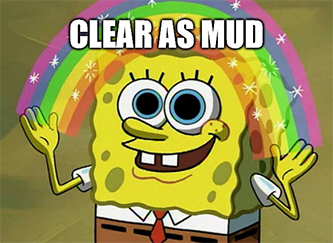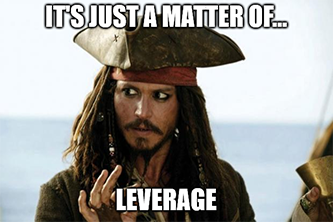
What’s The Deal With Options Trading?
So, you want to trade options, but you don’t know where to start…
With options, you clearly have, well … options. There are puts, calls, spreads, straddles, strangles, condors, butterflies, ladder spreads, calendar spreads … one might say you’re spoiled for options, Great Ones.
Sure, you could go running off to some far-flung Reddit message board to “YOLO some sweet tendies on a GME May $1,000 call so you can buy more spicy nugs” and learn about the pitfalls of options trading the hard way.
For some of you — you know who you are! — that might actually be fun. Kinda like playing Russian roulette with your retirement.
But for the rest of us… Naw, dawg. We need a safer, more down-to-Earth start on this whole options shindig.
That’s where I come in, Great Ones.
Today, I’m giving you the skinny on options trading with as few technical terms as possible to make it easily digestible … like that chocolate Ensure you drank for breakfast this morning.
And, if you’re really interested in options trading and the massive returns it can provide, I’ll have an excellent opportunity for you to learn more at the end … so stay tuned!
(Note: All you armchair professional options traders … you’ll want to stay tuned as well. I’m pretty sure you haven’t seen anything like this opportunity in a long time.)
Options 101: In The Beginning…
All right … options trading. Where to begin?
Umm … Mr. Great Stuff, what’s an option?
Oh … we’re starting at the very beginning, are we? That’s OK! We’ve all gotta start somewhere.
In the simplest terms, the most convenient definitions, an option is a contract that gives you the right (but not the obligation) to buy or sell a stock at a certain price.
Like all contracts, an option contract has two sides: the side that writes (or sells) the contract and the side that buys the contract.

As is typical with most contracts, options don’t last forever. They expire after a certain time, typically on monthly, weekly or yearly intervals.
After all, you don’t want these things sitting out there until the end of time … then they’d just be stocks, you know?
You still with me?
Yessir! Options contracts let you buy or sell stocks at a set price by a set day.
Good! Now, this is where it gets a bit messy … but only a bit.
So, each option contract typically represents 100 shares of a stock. Let’s say you’re looking to trade Apple (Nasdaq: AAPL) options. Each one of those Apple options controls 100 shares of AAPL stock.
This brings us to our first important lesson: When you look up option prices, the price you’ll see is for each individual share in a contract. Yet, your option contract lets you control a whopping 100 shares! (Take that, stock investors.)
For the option prices you see online, multiply the price by 100 to arrive at the total cost of your contract.
For instance, let’s say you’re looking up AAPL options that expire in April. You see that an AAPL April $200 strike call option is priced at $2. (This is just an example price … your results will vary.)
Hold up … a $200 call strike? Who are we calling, and what are we striking?
A “call” typically means you want to buy something, or you think a stock will go up … but I’ll explain more on that in just a minute. Patience, grasshopper.
“Strike,” however, is fancy options trading lingo for the price at which you want to buy or sell a stock. So, a $200 strike call option means you want to pay $200 for AAPL shares.
Now, you might think that you can buy that option contract for just $2 … nope. That certainly would be a steal, but it ain’t happening.
Remember, you need to multiply that $2 by all 100 AAPL shares that the contract represents.
As such, your AAPL April $200 call would actually cost you $200. That may seem steep, but it’s a lot cheaper than buying 100 shares of Apple at $200 each. In fact, at these prices, Apple options traders can literally control 100 AAPL shares for the price of one!
This, class, is called leverage!
Options allow you to take an interest in a stock with much less money than you would otherwise need to buy the shares outright. It’s the entire reason that people trade options to begin with.
I know that’s a lot to take in. But, if you’re still following along, you’re doing fine!
Put Me On & Call Me Maybe?

I love getting more leverage in my trades … but what’s a “call?” Time for some ‘splaining!
OK, so there are two basic types of options: calls and puts.
A call option is a contract that gives you the right (but not the obligation) to buy a stock at a certain price (or strike) in a certain time frame.
That AAPL April $200 strike call I mentioned above? It lets you buy 100 shares of AAPL for $200 each before the contract expires in April.
Similarly, a put option is a contract that gives you the right (but not the obligation) to sell a stock at a certain price (or strike) in a certain time frame. Keeping the Apple example, an AAPL April $200 put option would allow you to sell 100 shares of AAPL for $200 before the contract expires in April.
Why would you ever want to buy a put option? Well, if you own the shares or you’ve purchased a call option, you can only make money if the stock goes up. But, contrary to popular belief, “stonks” don’t always go up.
It’s sad, I know. But it’s true.
Even the strongest, most bullish stocks in the world pull back eventually … and you may as well make money on them in the meantime. That’s where put options come in.
Because I’m All About Value…
But Mr. Great Stuff, what if I don’t want to buy 100 shares of Apple? What if I can’t afford that?!
What, you don’t have $20,000 just lying around to buy AAPL stock? Amateurs…

Don’t worry. Don’t worry.
While some people use options to actually buy and sell stock, most traders cash in their options before they even expire!
That’s right: You can use options to make money off the contracts themselves — without ever touching a single share of the stock.
Remember, an option gives you the right (but not the obligation) to buy or sell the stock.
As a stock goes up and down in value, so does the value of options on that stock. Specifically, a call option climbs in value when the stock goes up and falls in value when the stock goes down. (Vice versa with put options.)
To keep this simple, we won’t go into the complicated way that options are priced. Just know that there are three factors that determine an option’s price:
• Intrinsic value — The actual price of the option contract minus all other outside influences.
• Time value — The portion of an option’s price assigned to the amount of time left on the contract. Typically, the longer you have for a stock to make the move you want, the more you’ll pay for that window of safety.
• Implied volatility — This one can get weird. It’s essentially the market’s estimate of how much a stock will move in a given amount of time. Basically, the price is higher for stocks that move a lot and lower for stocks that don’t move much at all.
That’s a lot of scary stuff right there … and I even kept the descriptions as simple as possible.
When you buy an option, you pay for three things: the option (intrinsic value), the time that option is open (time value) and how much the market thinks that stock will move (implied volatility).
When your contract expires, its time value and implied volatility fall to zero — there’s no time left on the contract for the stock to keep moving.
Simply Having A Wonderful Options Time!
I’m going to make this even simpler. For now, let’s only look at the intrinsic value in our Apple example.

Let’s assume that AAPL stock soared to $210 after you bought your AAPL April $200 call option. Congrats!
When your AAPL April $200 call option expires, the intrinsic value of that option would be $10, or $1,000 for the entire contract. Remember, you multiply the price of the option by 100 to get the full value of the contract.
Since we paid a total of $200 for the contract, our profit would be $800. Easy peasy — you made a helluva nice gain on your AAPL call contract.
But what if you originally thought AAPL stock would plummet? Let’s run through an example where you bought a put option instead of a call. Remember, puts gain value when a stock goes down.
Say you bought an AAPL April $150 put option for $2. Again, that tallies up to $200 per contract. And let’s say that you made the right decision once again — look at you, already a pro! — and AAPL stock crashed while you held your put option.
Apple stock ends up trading at $140 when your put option expires. That option’s intrinsic value would be $10, or $1,000 for the full contract. Our profit again would be $8, or a grand total of $800 for the contract.
Clear as mud, right?
What happens if AAPL is below $200 when the call option, what did you call it … expires?
Good question. Even with all the expertise and foresight in the world, not every trade goes our way. But oftentimes, taking a loss in an option trade won’t sting as much as if you held the stock.
That said, remember our golden rule with options! Like all investing, never invest more than you’re willing to lose.
In the AAPL April $200 call example, if Apple shares are below $200 when your contract expires in April … you get nothing. Nada. Zip. It’s a 100% loss. The same is true for the AAPL April $150 put option. If Apple is above $150 when this April put contract expires, you get a big ol’ zero.
The great thing is that your initial investment is all you can lose when buying an option. (That’s a great thing?!) Remember that options are a leverage game, letting you control more shares for a fraction of the cost.
One Word: Leverage
Let’s put that 100% loss into perspective.
You paid $200 for your AAPL call option, right? That lets you control 100 shares. To buy those same 100 shares, it would’ve cost you $20,000. With $200, you can only afford one share of APPL stock.

If AAPL stock falls to $140, your call option is a complete loss — $200 down the drain. If you owned one share of AAPL stock, you’re only out about $60 … if you manage to sell it at $140.
But that’s with only one share of AAPL stock. If you owned all 100 shares, your loss is $6,000. That’s way more than what you paid for the option.
Meanwhile, if AAPL rallies to $210, you only made $10 on that one share.
But that AAPL $200 call option? It’s worth $1,000 — the same as if you’d owned all 100 shares — and yet you only paid $200 and not $20,000 to get the same dollar return.
That’s what leverage really means: It lets you keep a smaller chunk of your portfolio invested in any one trade … for even more profit potential!
So, let’s recap today’s Options 101 lessons:
• Options are contracts to buy or sell a stock at a certain price in a certain time frame.
• A contract’s “strike price” is the price at which you want to buy or sell the stock.
• Options contracts represent 100 shares of a stock.
• To get an option’s actual price, you multiply the price by 100.
• Buying a call option is a bet that a stock will rise.
• Buying a put option is a bet that a stock will fall.
Capisce? Good.
Elite Options Trading 101

Great Ones, you’ve just read (or skimmed through) my basic introduction to options trading.
I tried to make it as easy to understand as possible … in my own unique Great Stuff way.
But I know full well that many of you aren’t particularly fond of my particular turn of phrase — I’m looking at you, Frederick.
So, I have a special alternative for you … nay, an opportunity!
An opportunity to not only learn everything you ever wanted to know about options trading but to also achieve a potential options trading win rate of 78%!
Let me just tell you that a 78% win rate in the options trading world is ridiculously high. Ask any of your options trading friends, and they’ll tell you the same thing. But I’ve seen behind the curtain on this strategy, and I’m blown away at its results.
My friend and colleague Ian King — whom you may also know as Ian “The Crypto” King — is launching a brand-new options trading service on January 20 designed around a very special and very unique trading strategy: Profit Framing.
As you know, stocks don’t always go up. Nor do they always go down. In fact, 80% of the time, the stock market just sits there, trending sideways and not doing a whole lot of anything … very boring and typically very unprofitable.
But Ian’s Profit Frame strategy is unlike anything you may have seen before. It actually pays you up front for every trade you make — and gives you the chance to collect thousands in profits in as little as three weeks.
But, Mr. Great Stuff, I just learned what a put and a call are! Wouldn’t it be crazy of me to sign up?
First, you’re not crazy. We don’t use that word here.
Second, Ian knows that not everyone knows options.
That’s why, when you sign up for Ian’s service on January 20, you’ll get 24/7 access to Profit Frame Trading 101: a three-part video tutorial that walks you through everything I covered about options above and so, so much more.
Ian’s three-part video series literally educates you on everything you need to know to get started trading options, including how Profit Frame trading works!
So, I have to wait until January 20?
Well, yes and no. Yes, Ian’s Profit Frame strategy goes live on January 20. No, you don’t have to wait until then to get started!
You can sign up for VIP Access right now!
Click here to get VIP Access to Profit Framing with Ian King on January 20.
And, as a special double-bonus, if you provide your phone number when registering, you get super-double-secret VIP Plus access — which gets you Ian’s own special options report: Options 101: A Guide to Options Trading — which goes into deeper detail with tones of useful options information.
What? You haven’t signed up yet? What are you waiting for?
Don’t let someone else grab your VIP Access!
Click here now to register for Profit Framing with Ian King now!
Thanks for tuning in for this week’s Great Chat. Have a great rest of your weekend!
If you have a stock or investing idea you’d like to see covered in the Great Stuff weekend edition, let us know at: GreatStuffToday@BanyanHill.com.
And if you have that burning yearning that only more Great Stuff can satisfy, you should check out our deets here:
- Get Stuff: Subscribe to Great Stuff right here!
- Our Socials: Facebook, Twitter and Instagram.
- Where We Live: GreatStuffToday.com.
- Our Inbox: GreatStuffToday@BanyanHill.com.
Until next time, stay Great!
Regards,
Joseph Hargett
Editor, Great Stuff




